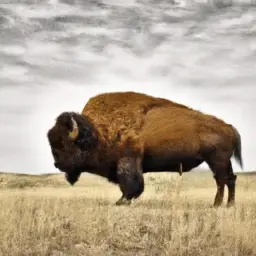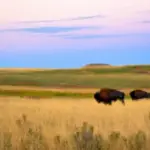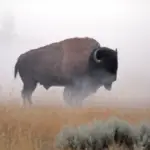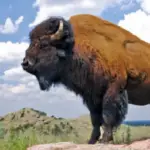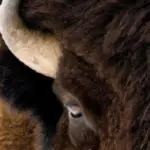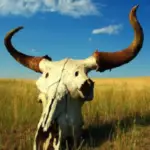Imagine a world where wild bison roam freely, thriving in their natural habitat across vast expanses of land. Well, that world is not just a dream anymore! With the incredible new product, “How Much Land Does A Bison Need,” you can learn all about these majestic creatures and the importance of providing them with adequate space to flourish. This fascinating article will take you on a journey through the fascinating lives of bison and highlight the significance of conservation efforts in preserving their habitats. Get ready to be captivated by the wonders of nature and discover how you can make a difference in protecting these magnificent animals.
Understanding Bison Basics
The biological structure of Bison: Anatomy and Physiology
Bison, also known as American buffalo, are large, herbivorous mammals that belong to the Bovidae family. They have a robust and muscular build, with a shoulder height ranging from 5 to 6.5 feet and a weight ranging from 900 to 2,200 pounds. These majestic creatures possess a distinctive hump on their shoulders, which is composed of dense muscle. Their heads are massive, with a pair of curved horns that are characteristic of both male and female Bison. They also have a dense and shaggy coat, primarily consisting of brown or black hair, with a lighter coloration on their underbelly. Overall, Bison are well-adapted to survive in different environments, with their strong physique and specialized features.
The different species of Bison
There are two recognized species of Bison: the American Bison (Bison bison) and the European Bison (Bison bonasus). The American Bison can be further divided into two subspecies: the Plains Bison (Bison bison bison) and the Wood Bison (Bison bison athabascae). While the American Bison is predominantly found in North America, ranging from Canada down to Mexico, the European Bison is native to Europe, specifically in countries such as Poland, Belarus, and Russia. Although these species share many similarities in terms of their physical attributes and ecological roles, their genetic differences have resulted in some distinct characteristics and variations in habitat preferences.
The geographical distribution of Bison globally
Bison, once found in vast numbers across North America, experienced a severe decline due to overhunting and habitat loss. However, conservation efforts have successfully restored their populations to an extent. Today, the American Bison is predominantly found in protected areas and national parks throughout the United States and Canada. Their range includes the Great Plains, Rocky Mountains, and various grasslands and prairie ecosystems. On the other hand, the European Bison population is concentrated in Poland, where efforts have been made to reintroduce them into suitable landscapes for their survival. These geographically diverse distributions are a testament to the adaptability and resilience of Bison in different habitats.
Bison as Grazer
Bison’s diet and feeding habits
Bison are grazer species, meaning that they primarily consume vegetation such as grasses, sedges, and herbaceous plants. They are well-suited to thrive on a diet consisting mainly of grass, which accounts for approximately 90% of their food intake. Bison have a unique feeding pattern, as they use their strong tongues and sharp incisors to grasp and tear grass, as well as other plant material. Their feeding habits involve selecting the most nutritious plants, favoring new growth and tender leaves. They are often seen in groups, moving steadily across the landscape in search of grazing opportunities.
The role of Bison in the ecosystem
Bison play a crucial role in shaping and maintaining their surrounding ecosystems. As grazers, they have a profound impact on vegetation dynamics, initiating a process known as “ecological disturbance.” Through their feeding habits, Bison can control the growth and composition of plant communities, leading to changes in vegetation structure. By consuming tall and coarse grasses, they create gaps and open spaces for new growth. This, in turn, encourages the regeneration of diverse plant species and stimulates ecological succession. Additionally, Bison also serve as a catalyst for nutrient cycling, as their droppings contribute to the enrichment of soil fertility.
The impact of food availability on Bison habitat
Food availability plays a significant role in determining the distribution and habitat requirements of Bison. They are highly mobile animals and rely on extensive foraging areas to meet their nutritional needs. A sustainable population of Bison requires abundant and diverse vegetation resources, ensuring a constant food supply throughout the year. Consequently, changes in food availability, such as seasonal variations or disturbances caused by weather events, can greatly influence Bison movements and habitat selection. Understanding their dietary requirements and the factors affecting food availability is crucial for effective conservation and management strategies.
Bison and Their Habitat
General habitat requirements for Bison
Bison exhibit a preference for open grasslands and prairies, which provide the ideal environment for their grazing activities. They are adaptable animals and can utilize a range of habitats, as long as there is an ample supply of nutritious vegetation. Besides the availability of food, other important habitat requirements for Bison include access to water sources, suitable shelter, and protection from extreme weather conditions. They tend to avoid dense forests and areas with excessive tree cover, as it hinders their grazing behavior and limits their visibility.
The impact of climate and terrain on Bison
Both climate and terrain greatly influence the distribution and movements of Bison. Different species and subspecies of Bison have adapted to varying climatic conditions and their accompanying landscape features. For example, the American Bison thrives in the wide-open plains and grasslands of North America, where they are well-equipped to withstand hot summers and cold winters. On the other hand, the European Bison is adapted to survive in colder climates, often occupying wooded areas with dense vegetation for cover. Although Bison can navigate various terrains, including hilly regions and habitats with diverse topography, their overall distribution is influenced by the climatic conditions and terrain characteristics of their preferred habitats.
Adaptations of Bison according to different environments
Through evolutionary processes, Bison have developed adaptations that allow them to survive in different environments. Their sturdy build and specialized physiological features enable them to withstand harsh conditions and thrive in a range of habitats. For instance, their high shoulder hump, composed of dense muscle, aids in supporting their massive head and contributes to their ability to dig through snow to reach forage. Bison also possess a thick fur coat that provides insulation during colder periods, as well as a specialized respiratory system that allows them to efficiently process oxygen at higher altitudes. These remarkable adaptations reflect the resilience and versatility of Bison in diverse ecological settings.
Bison Land Requirements: General Overview
Factors affecting land requirements for Bison
Several factors influence the land requirements of Bison. The size of their population, food availability, water sources, and suitable habitat structure all play vital roles in determining the amount of land necessary for their survival. A larger population of Bison will naturally require a larger land area to fulfill their grazing needs and minimize competition for resources. Additionally, the quality and quantity of available food sources are essential considerations, as Bison require a well-rounded diet for their optimal health and reproduction. Accessible water sources are also crucial, as Bison need regular hydration. Lastly, the presence of suitable habitat structures, such as open grasslands and prairies, with minimal human disturbance, greatly influences Bison land requirements.
Differences in land requirements among Bison species
Different species of Bison have varying land requirements based on their distinct adaptations and ecological preferences. For example, the Plains Bison, which occupies vast grasslands in North America, requires extensive areas to support its large population and grazing habits. This species is known for its ability to cover great distances in search of food and water, necessitating a considerable land area for their sustenance. On the other hand, the Wood Bison, found in the boreal forests of Canada, has a smaller population and typically has a more restricted habitat range. They primarily inhabit areas with suitable forage and prefer habitats that offer cover from predators.
Impact of Bison’s body size on the land required
The body size of Bison has a direct impact on their land requirements. Larger-bodied individuals have greater energy and nutritional needs, which in turn necessitate a larger grazing area to meet these demands. Male Bison, on average, have a larger body size than females, and their larger stature requires more resources. Consequently, Bison herds with a higher proportion of adult males may require a more extensive land area to ensure adequate forage availability. Similarly, nursing mothers have higher energy requirements due to lactation, and providing them with sufficient grazing areas is essential for their reproductive success. Taking into account the varying body sizes within a herd is crucial for managing land requirements and the overall well-being of the Bison population.
Minimal Land Requirements
Minimal land size needed for a single Bison
While land requirements for Bison can vary based on factors such as population density and habitat quality, a minimum land size is necessary to sustain a single Bison. In general, an estimated 100 to 250 acres of suitable habitat can provide enough resources for a single Bison. This includes a mix of open grasslands, access to water sources, and shelter from extreme weather conditions. The availability of nutritious vegetation within this allocated land is critical to ensure the health and longevity of a solitary Bison.
Minimal habitat types suitable for Bison
For a single Bison, suitable habitat types should possess specific characteristics necessary for their survival. Open grasslands and prairie ecosystems are ideal, as they provide abundant grazing opportunities and allow Bison to move freely. These habitats should have adequate vegetation cover, with a diverse mix of grasses, sedges, and herbaceous plants that meet the Bison’s nutritional needs. Additionally, the presence of reliable water sources, such as rivers, streams, or waterholes, is essential for hydration. Lastly, minimal human disturbances, such as vehicular traffic and noise pollution, are crucial to promoting a stress-free environment for the solitary Bison.
Importance of dietary and water availability in minimal lands
In minimal lands for a single Bison, dietary and water availability play a crucial role in their survival and well-being. A diversified diet, comprising a wide range of plant species, is necessary to ensure that the Bison receives adequate nutrition. The presence of nutritious grasses, especially during the growing season, is essential for maintaining their optimal body condition and reproductive success. Similarly, access to clean and reliable water sources is vital for hydration and thermoregulation, especially during hotter periods. Consistent availability of both food and water within the minimal land size facilitates the Bison’s ability to thrive in its habitat.
Land Requirements for Bison Herds
Average size of Bison herds
Bison are known to form herds, which consist of multiple individuals that live and move together as a social unit. The size of these herds can vary, with the average ranging from 30 to 50 individuals. However, in some cases, Bison herds can reach several hundred members, especially during periods of migration or seasonal congregation. The composition of a herd also varies, typically consisting of females, their calves, and a smaller number of adult males. The size and structure of Bison herds influence their land requirements, as larger herds necessitate more extensive grazing areas to sustain their population.
Land size needed for Bison herds
The land size needed for Bison herds depends on several factors, including herd size, food availability, and habitat quality. As mentioned earlier, a larger herd requires a larger land area to ensure an adequate food supply for all individuals. Bison herds are highly mobile, and their movements often span considerable distances as they search for suitable grazing opportunities. The availability of diverse vegetation types and sufficient water sources within the land area are crucial for supporting the nutritional needs of a herd. Therefore, an estimated range of 1,000 to 2,500 acres of suitable habitat is typically required to sustain a Bison herd.
Importance of roaming and grazing areas for herd stability
Roaming and grazing areas play a vital role in maintaining the stability of Bison herds. Bison are highly nomadic and require freedom of movement to find suitable forage and water sources. Adequate grazing areas provide the necessary nutrition to sustain the herd and contribute to the reproductive success of individuals. The ability to roam across large areas also minimizes competition for resources and allows for social interactions within the herd. By ensuring the availability of ample roaming and grazing areas, the stability and overall health of Bison herds can be maintained, promoting their long-term viability and success.
Bison Ranching Demands
Understanding Bison ranching and its popularity
Bison ranching refers to the practice of raising Bison in captivity for various purposes, including meat production, conservation, and educational initiatives. Over the years, Bison ranching has gained popularity due to several factors. The nutritional value of Bison meat, which is low in fat and high in protein, has contributed to the increased demand for their products. Furthermore, Bison ranching offers opportunities for landowners to diversify their agricultural practices and contribute to Bison conservation efforts. The resilience and adaptability of Bison, along with their cultural and historical significance, have also made them attractive for educational programs and tourism.
Land requirements for starting a Bison ranch
Starting a Bison ranch involves considerable planning, including assessing the land requirements necessary to accommodate the Bison population. The land size needed for a Bison ranch depends on the intended herd size, the management practices employed, and the availability of suitable grazing areas. An average Bison ranch typically requires a land area of at least a few hundred acres, providing enough space for grazing, shelter, and other facilities. Additionally, the presence of reliable water sources and appropriate fencing is essential for maintaining the security and well-being of the Bison herd. Adequate planning and consultation with experts can help ensure the success of a Bison ranching venture.
Considerations for Bison ranch size selection
Selecting the appropriate size for a Bison ranch involves considering several factors, including the intended purpose and goals of the ranch, financial resources, and available land. The size of the ranch will depend on the desired herd size, the capacity of the land to sustain that herd, and the management practices in place. It is crucial to establish a balance between the size of the Bison population and the land’s carrying capacity to prevent overgrazing and degradation of the habitat. Additionally, the scalability of the ranch should be considered, allowing for potential expansion or modification in the future. Considering these factors will help ensure the viability and long-term sustainability of the Bison ranch.
Impacts of Overcrowding Bison
Dangers posed by insufficient land for Bison
Overcrowding Bison populations due to insufficient land can have detrimental effects on both the animals and the environment. Limited land availability can lead to increased competition for resources, such as food and water, among individuals within a herd. This can result in compromised nutrition and overall poor health of the Bison, leading to growth limitations, reduced reproductive success, and an increased susceptibility to diseases. In addition, overcrowding creates elevated stress levels, aggression, and increased territorial disputes within the Bison population. Ultimately, insufficient land can disrupt the natural balance and ecological harmony of Bison communities.
Effects of land shortage on Bison’s health and wellbeing
Shortage of land for Bison can have significant effects on their health and overall wellbeing. Insufficient grazing areas can lead to malnutrition, as Bison may resort to consuming less nutritious plant material or feed on depleted forage. This can result in weight loss, weakened immune systems, and increased vulnerability to diseases. Furthermore, limited availability of space can lead to overcrowding and increased stress levels among individuals, which negatively impacts their mental and physical health. Bison may exhibit abnormal behaviors, such as pacing, aggression, or self-mutilation, as a response to restricted movement and environmental stressors. Providing adequate land is crucial to ensuring the health and wellbeing of Bison populations.
Understanding Bison’s stress response and behavior under limited space
Bison, like many other animal species, have a stress response system that becomes activated under various environmental stressors, including limited space. When facing insufficient land, Bison may exhibit behavioral changes as a response to stress. Increased aggression, territorial disputes, and social disruption are commonly observed in overcrowded populations. Bison may also display repetitive behaviors, such as weaving or pacing, as an expression of anxiety and frustration. These behavioral changes can have cascading effects on the overall social dynamics and wellbeing of the Bison population. Recognizing and mitigating these stress responses is essential to ensure the welfare and conservation of Bison in managed environments.
Strategies for Efficient Land Use
Practices for maximizing land utility for Bison
Efficient land use practices can contribute to maximizing the utility of land for Bison. Implementing rotational grazing systems allows the land to properly recover from grazing pressure and ensures a consistent supply of nutritious vegetation. By dividing the grazing area into smaller sections and periodically rotating the Bison herd, the rest of the land can regrow, preventing overgrazing and stimulating the growth of diverse plant species. Additionally, managing water sources strategically, such as creating waterholes or managing wetlands, can help concentrate the grazing activities, reducing the pressure on vegetation in other areas. These practices promote sustainable land use and support the long-term health and productivity of the Bison population.
Importance of land management in Bison conservation
Effective land management is essential for the conservation of Bison populations. By implementing sound land management practices, the key ecological requirements of Bison can be fulfilled, ensuring the sustainability of their habitats. Land management techniques can include the restoration and maintenance of grasslands, the removal of invasive plant species, and the preservation of diverse vegetation communities. Additionally, managing human activities, such as vehicle traffic and infrastructure development, in Bison habitats minimizes disturbances and reduces stress on the population. An integrated approach to land management, combining ecological principles and conservation objectives, is crucial for the long-term success of Bison conservation efforts.
Innovative methods in Bison agriculture and ranching
Innovative methods in Bison agriculture and ranching can contribute to sustainable land use and the welfare of captive Bison populations. Employing regenerative agriculture techniques, such as holistic planned grazing and soil restoration, can enhance the productivity and resilience of grassland ecosystems while minimizing environmental impacts. The use of technology, such as GPS tracking and remote sensing, can aid in monitoring Bison movements and habitat utilization, allowing for adaptive management strategies. Furthermore, the integration of Bison into agroforestry systems or the practice of silvopasture can provide additional benefits, such as shade, shelter, and diverse forage options. These innovative approaches enhance Bison agriculture and ranching practices while promoting ecological sustainability.
How did the Bison Population Decline affect their Need for Land?
The 1800 bison population analysis revealed a sharp decline in numbers, impacting their need for land. As their population dwindled, bison required less space to graze and roam. However, this also led to increased competition for dwindling resources, further exacerbating the decline.
Future Trends and Considerations
Effects of climate change on Bison land needs
Climate change poses considerable challenges to Bison populations and their land requirements. The warming climate and accompanying changes in precipitation patterns can impact vegetation growth and availability, altering the composition of their grazing habitats. This may require Bison to shift their ranges in search of more suitable conditions, potentially increasing their competition for limited resources. Moreover, extreme weather events, such as droughts or severe storms, can disrupt food availability and access to water sources, further impacting Bison populations. Understanding and anticipating the effects of climate change on Bison land needs will be crucial for implementing adaptive management strategies and ensuring their long-term survival.
Influence of human development and encroachment on Bison habitats
Human development and encroachment pose significant threats to Bison habitats, leading to habitat fragmentation, loss of suitable forage, and increased human-wildlife conflicts. As human populations expand and urban areas expand, Bison habitats become increasingly disrupted and fragmented, limiting their ability to access suitable grazing areas. Roads, fences, and infrastructure development can act as barriers to Bison movement, isolating populations and reducing their genetic diversity. The preservation and restoration of large, interconnected landscapes and the implementation of conservation corridors are crucial for maintaining and restoring Bison habitats. Balancing human development with the conservation needs of Bison is essential for ensuring their long-term survival.
Possible future trends in Bison land requirements
Future trends in Bison land requirements will depend on a variety of factors, including habitat availability, population growth, and climate change impacts. As conservation efforts continue to restore Bison populations, the demand for suitable grazing areas may increase. This could lead to the expansion of protected areas and the establishment of additional Bison reserves or ranches. However, the impacts of climate change, such as shifts in vegetation distribution and availability, may also influence future trends in land requirements. Adaptation strategies and flexibility in management approaches will be crucial to meeting the evolving land requirements of Bison populations.
Legal and ethical considerations for Bison land use
Legal and ethical considerations play a vital role in Bison land use and management decisions. Ensuring compliance with relevant laws and regulations pertaining to wildlife conservation, land use rights, and sustainable practices is essential. This includes obtaining the necessary permits and adhering to guidelines for Bison ranching or protected area management. Additionally, ethical considerations should acknowledge the intrinsic value of Bison as sentient beings and promote their welfare and wellbeing. Balancing human needs and interests with the conservation of Bison, their habitats, and overall biodiversity is crucial for fostering harmonious and sustainable relationships between humans and these magnificent animals.
In conclusion, understanding the land requirements of Bison is critical for their conservation and management. Their physiological adaptations, grazing behaviors, and social dynamics influence their habitat preferences and overall land needs. Factors such as food availability, water sources, and suitable habitat structure play significant roles in determining the land requirements for both individual Bison and herds. Efficient land use practices, innovative ranching methods, and adaptation to future trends and challenges, such as climate change and human development, are essential for ensuring the long-term survival and well-being of Bison populations. By integrating legal and ethical considerations into land use decisions, we can foster a sustainable coexistence between Bison and human communities, preserving their ecological importance and cultural significance for generations to come.

